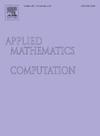Numerical simulation of time fractional Allen-Cahn equation based on Hermite neural solver
IF 3.4
2区 数学
Q1 MATHEMATICS, APPLIED
引用次数: 0
Abstract
In this paper, we introduce a high-precision Hermite neural network solver which employs Hermite interpolation technique to construct high-order explicit approximation schemes for fractional derivatives. By automatically satisfying the initial conditions, the construction process of the objective function is simplified, thereby reducing the complexity of the solution. Our neural networks are trained and fine-tuned to solve one-dimensional (1D) and two-dimensional (2D) time fractional Allen-Cahn equations with limited sampling points, yielding high-precision results. Additionally, we tackle the parameter inversion problem by accurately recovering model parameters from observed data, thereby validating the efficacy of the proposed algorithm. We compare the relative error between the exact solution and the predicted solution to verify the robustness and accuracy of the algorithm. This analysis confirms the reliability of our method in capturing the fundamental dynamics of equations. Furthermore, we extend our analysis to three-dimensional (3D) cases, which is covered in the appendix, and provide a thorough evaluation of the performance of our method. This paper also conducts comprehensive analysis of the network structure. Numerical experiments indicate that the number of layers, the number of neurons in each layer, and the choice of learning rate play a crucial role in the performance of our solver.
基于Hermite神经解算器的时间分数阶Allen-Cahn方程数值模拟
本文介绍了一种高精度的Hermite神经网络求解器,它利用Hermite插值技术构造分数阶导数的高阶显式逼近格式。通过自动满足初始条件,简化了目标函数的构造过程,从而降低了求解的复杂性。我们的神经网络经过训练和微调,可以在有限的采样点下解决一维(1D)和二维(2D)时间分数艾伦-卡恩方程,从而产生高精度的结果。此外,我们通过从观测数据中准确恢复模型参数来解决参数反演问题,从而验证了所提出算法的有效性。我们比较了精确解和预测解之间的L2相对误差,以验证算法的鲁棒性和准确性。这一分析证实了我们的方法在捕捉方程基本动力学方面的可靠性。此外,我们将分析扩展到附录中涵盖的三维(3D)案例,并对我们的方法的性能进行了全面的评估。本文还对网络结构进行了综合分析。数值实验表明,层数、每层神经元数和学习率的选择对求解器的性能起着至关重要的作用。
本文章由计算机程序翻译,如有差异,请以英文原文为准。
求助全文
约1分钟内获得全文
求助全文
来源期刊
CiteScore
7.90
自引率
10.00%
发文量
755
审稿时长
36 days
期刊介绍:
Applied Mathematics and Computation addresses work at the interface between applied mathematics, numerical computation, and applications of systems – oriented ideas to the physical, biological, social, and behavioral sciences, and emphasizes papers of a computational nature focusing on new algorithms, their analysis and numerical results.
In addition to presenting research papers, Applied Mathematics and Computation publishes review articles and single–topics issues.

 求助内容:
求助内容: 应助结果提醒方式:
应助结果提醒方式:


